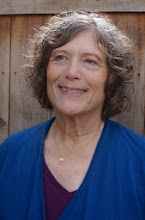

As I queried in our newletter, breathes there anybody with soul so dead as not to love baby blue eyes? Low-growing, good for the front of the flower border, and stunning in large containers, baby blue eyes is a universal favorite. It can be sown this time of the year in the midwest and east coast; Californians and West Coasters would have to supply the necessary irrigation for germination and early growth, and a part-shade spot would be preferable. My large mass of nemophilas, blooming full on now May 17, was sown in late January, here on the north-central coast.
Five spot is equally delightful; there is no choosing between the two. I have sat for hours on a chair in the middle of our planting, watching native bumblebees and other pollinators go after the nectar these open cupped flowers freely offer. They take longer on each flower than on other nearby wildflowers, like Chinese houses or sky lupine, perhaps because there is more to get.
I sowed one stand in part-shade and one in the open in rich soil, another in the open in less rich soil, with more undigested woody material. I'm fond of the latter space because all the wildflowers are small, reminding me of how they look in certain wild places on very lean soil.
Because I have spent years describing plants, I am always appreciative of those botanists of the past who have allowed themselves to wax eloquent about our California natives, fleshing out the dry taxonomical description with their own emotional reactions to the plants. Isn't that what it's all about?
I agree with herbalist Stephen Buhner, whose wonderful book, The Lost Language of Plants, we offer. I take his philosophy to mean that a way a plant makes you feel - that is that plant's medicine. Masses of yellow composites, such as Tidy Tips (Layia platyglossa), and Goldfields (Lasthenia glabrata), lift my spirits - hence, they are anti-depressants. It's a tangible physical and mental phenomenon, with a chemical basis. Baby blue eyes makes me think that life is sweet; here's what some other botanists of the past have said about it:
"When skies are smiling and the earth is already clothed with a luxuriant and tender herbage, we find upon some balmy morning that the baby-eyes have opened in gentle surprise upon the lovely world. The spring breezes blow over no more beautiful and ethereal flowers than these. Companies of them open together, dotting the sward and luring us on from one to another, the one just beyond always seeming a little brighter blue or a little more captivating than those near at hand, till we are beguiled into filling our hands with them.
These delicate blossoms vary greatly in size and color. The largest and finest I ever saw grew upon the flower-sprinkled slopes of Lake Merced, near San Francisco."
From the campanulate, half-opened buds, it has been called "California bluebell," and among the Spanish-Californians it is known as "Mariana."
Mary Elizabeth Parsons, The Wild Flowers of California," 1955.
Any botanists of San Francisco still seeing "Mariana" on the slopes of Lake Merced? These descriptions tell us what was where once, and also, what might be restored. The custom of common naming flowers after women and women after flowers persists in many cultures. We have Rose, Daisy, Lily, the Spanish had Mariana, and the Coast Miwok, where I live, named some women Silai, after checkerbloom, Sidalcea malvaeflora. Other examples out there?
Here's Leslie L. Haskin, writing in 1934 in Wild Flowers of the Pacific Coast, about baby blue-eyes: "They are among the most delicate and charming of our flowers, an epitome of modesty and purity. Compared with the size of the plants, the flowers are very large, often one to one anda half inches across. They are reaised on slender peduncles well above the foliage, so that in a breeze they nod and flutter like white butterflies."
Writing in more modern times is John Thomas Howell, whose beloved Marin Flora is due to be republished in updated form this August: Certainly this (Nemophila menziesii) is one of the most beautiful and best-beloved wildflowers of the spring,a high favorite with everyone...In low wet fields and on springly slopes in the hills a quite different form with white corolla dotted with black or dark blue is sometimes locally abundant. This type is N. menziesii var. atomaria..."
Once some years back we did a small grow-out of the above variety of baby blue eyes,Nemophila menziesii var. atomaria, white with black or blue spots, and were able to briefly add it to our seedlist. It was also delightful in containers. Doing these small grow-outs is my delight, but I can never keep up with all that I would like to be able to offer. Any seed collectors out there who would like to barter - we'd love to hear from you.




2 comments:
Congradulations, Judith! Wonderful post, with many more to follow I hope.
Lew
Thank you for sharing
I really like
Post a Comment